
About UsThe Numismatic Bibliomania Society is a non-profit organization promoting numismatic literature. For more information please see our web site at coinbooks.org SubscriptionsThose wishing to become new E-Sylum subscribers (or wishing to Unsubscribe) can go to the following web page link MembershipThere is a membership application available on the web site Membership Application To join, print the application and return it with your check to the address printed on the application. Membership is only $15 to addresses in the U.S., $20 for First Class mail, and $25 elsewhere. For those without web access, write to: David M. Sundman, Secretary/TreasurerNumismatic Bibliomania
Society AsylumFor Asylum mailing address changes and other membership questions, contact David at this email address: dsundman@LittletonCoin.com SubmissionsTo submit items for publication in The E-Sylum, just Reply to this message, or write to the Editor at this address: whomren@coinlibrary.com
BUY THE BOOK BEFORE THE COINSale Calendar
|
- WAYNE'S WORDS: THE E-SYLUM AUGUST 5, 2012
- NBS EVENTS AT THE 2012 PHILADELPHIA ANA CONVENTION
- NUMISMATIC LITERATURE DEALERS AT THE 2012 ANA CONVENTION
- NEW BOOK: HALF CENT QUICKFINDER, 2ND EDITION
- BOOK REVIEW: A GUIDE BOOK OF MORGAN SILVER DOLLARS, 4TH EDITION
- NEW MEDAL OF HONOR MUSEUM PLANNED IN CHARLESTON
- MORE ON SRI LANKAN NUMISMATICS
- NOTES FROM E-SYLUM READERS: AUGUST 5, 2012
- END OF RESEARCH TRAIL FOR LINCOLN MEDALIST BYRON M. PICKETT
- CARSON CITY COIN COLLECTION ARTICLES
- QUERY: AN ENGRAVED 1840-O HALF DOLLAR
- ANNA HYATT HUNTINGTON'S 1943 AFRICAN ANIMALS MEDAL
- ROBERT W. JULIAN NAMED ANA'S 2012 NUMISMATIST OF THE YEAR
- DAVID E. SCHENKMAN TO RECEIVE LIFETIME ACHIEVEMENT AWARD
- JOHN NEBEL AWARDED ANA'S MEDAL OF MERIT
- AN INTERVIEW WITH ROBERT HOGE
- ANS RAYMOND H. WILLIAMSON CORRESPONDENCE ARCHIVE
- TIME CAPSULE: A 1994 USENET POST ON THE 1783 NOVA CONSTELLATIO PATTERNS
- HUGH SCONYERS AND THE 1982 RARE COIN MARKET
- THE LONDON 2012 OLYMPIC MEDALS
- BELGIUM'S BELGA CURRENCY
- FEATURED WEB PAGE: UNITED STATES MINT POSTCARDS
WAYNE'S WORDS: THE E-SYLUM AUGUST 5, 2012

New subscribers this week include Robert Baglier and Francisco E. Latorre. Welcome aboard! We have 1,577 email subscribers, plus 185 followers on Facebook.
This week we open with a reminder of the NBS events at the ANA convention, as well as updates from numismatic dealers planning to attend. Next up is a new book announcement and a book review from John and Nancy Wilson.
Other topics include a new medal of Honor Museum, the Battle Born collection of Carson City coinage, and several recipients of ANA awards. To learn more about a new Noah's Ark coin, Hurricane Hugh, a curiously engaved 1840-O Half Dollar and the mint in heathen territory, read on. Have a great week, everyone!
Wayne Homren
Editor, The E-Sylum
NBS EVENTS AT THE 2012 PHILADELPHIA ANA CONVENTION
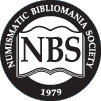 The Numismatic Bibliomania Society's 2012 Symposium (Thursday 11:30 a.m.-1:00 p.m., Room 106AB, Philadelphia Convention Center) will be a panel discussion:
The Numismatic Bibliomania Society's 2012 Symposium (Thursday 11:30 a.m.-1:00 p.m., Room 106AB, Philadelphia Convention Center) will be a panel discussion:
"Numismatic auction catalogs from various perspectives": David Fanning, dealer in used & rare numismatic literature at Kolbe & Fanning Numismatic Booksellers
Scott Rubin, collector & independent researcher (consultant to PCGS CoinFacts)
RyAnne Scott, ANA Library and Communication Director
Alan Stahl, curator of numismatics at Princeton University Numismatic Collection and cataloger for Paul Bosco Coins.
Vicken Yegparian, cataloger and vice-president of numismatics at Stacks Bowers.
The Numismatic Bibliomania Society's General Meeting (open to all) will be held Friday, August 10, 11:30 a.m.-1:00 p.m., in room 106AB of the Philadelphia Convention Center. In addition to being the annual business meeting for NBS, it will also include a discussion on "The Challenges and future of Numismatic Publishing" with Steve Roach (editor of Coin World) and Kerry Wetterstrom (editor & publisher of The Celator) and an auction of donated literature lots to benefit NBS.
To read the NBS web site events page, see: www.coinbooks.org/events/
To read the ANA's page for NBS events, see:
www.worldsfairofmoney.com/activities,-special-events-classes
/numismatic-bibliomania-society-symposium-and-general-meeting.aspx
NUMISMATIC LITERATURE DEALERS AT THE 2012 ANA CONVENTION
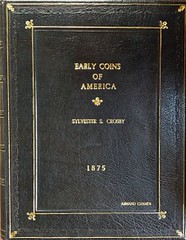 Kolbe & Fanning Numismatic Booksellers will be set up at the ANA's World's Fair of Money, August 7-11 in Philadelphia. Our booth number has changed and is different than what will be listed in the program. Our booth number is 1521. Please stop by and browse our selection of fine numismatic books, including rare plated auction catalogues, out-of-print standard references and important foundational works.
Kolbe & Fanning Numismatic Booksellers will be set up at the ANA's World's Fair of Money, August 7-11 in Philadelphia. Our booth number has changed and is different than what will be listed in the program. Our booth number is 1521. Please stop by and browse our selection of fine numismatic books, including rare plated auction catalogues, out-of-print standard references and important foundational works.
Highlights include finely bound copies of James Mease's 1834 work on American medals and his 1838 work on American coins (which Eric Newman has called "the first numismatic article on American coins published in America"). Other items include two original copies of Crosby, one featuring the rare Woodburytype plate of Dr. Maris, the other ex Armand Champa; a set of Rizzo on Sicily; plated Chapman sales including Jenks, Bement (American) and Warner; the Bathe book on Jacob Perkins; classic works on ancient coins, etc. Stop by Booth 1521 and check it all out!
David F. Fanning, Ph.D.
Kolbe & Fanning Numismatic Booksellers LLC
141 W. Johnstown Rd.
Gahanna, OH 43230
(614) 414-0855
Cell (614) 256-8915
Fax (614) 414-0860
df@numislit.com
www.numislit.com
I will be attending the American Numismatic Association Convention in Philadelphia August 5-11, 2012. Have me paged, or check the exhibit area, if you would like to sit down and talk about Numismatic Literature. Also Mail Bid Sale # 17 closing Saturday October 6th, 2012 is now on line at our web site.
 David Sklow-Fine Numismatic Books
David Sklow-Fine Numismatic Books
P.O. Box 6321
Colorado Springs, CO 80934
PH: 719-302-5686
FAX: 719-302-4933
EMAIL: numismaticbooks@aol.com
WEB: FineNumismaticBooks.com
I will be at ANA Philadelphia at tables 88-90.
Charles Davis
Numismatic Literature
P.O. Box 547
Wenham, MA 01984
Tel: (978) 468 2933
Fax: (978) 468 7893
http://www.numisbook.com
NEW BOOK: HALF CENT QUICKFINDER, 2ND EDITION
After 15 years, I am pleased to announce the second edition of my Half Cent Quickfinder for attributing die varieties. I am unofficially calling the project "QF2!"
Despite the fact that no new varieties have been discovered since 1997, a lot has changed with regards to the business strike issues of United States Half Cents. Technology and 15 years of experience have allowed me to streamline this work, and most importantly to increase the efficacy of the logical flow.
The old book was 64 pages. This one will be about 20 pages shorter. The format will be exactly the same: 5 1/2 X 8 1/2 format, black and white, and printed on a nice quality paper stock.
I will be at the ANA Convention to take pre-orders for the book. I am doing a small run of 250 copies to start. I am still toying what I am going to charge within a few dollars, but I will know by the time I leave. Also, I will have something set up on my website when I get back from the convention.
BOOK REVIEW: A GUIDE BOOK OF MORGAN SILVER DOLLARS, 4TH EDITION
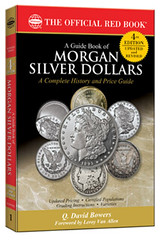 A Guide Book of Morgan Silver Dollars, A Complete History and Price Guide, 4th Edition/Updated and Revised, 2012, The Official Red Book, By: Q. David Bowers, Foreword by Leroy Van Allen,
A Guide Book of Morgan Silver Dollars, A Complete History and Price Guide, 4th Edition/Updated and Revised, 2012, The Official Red Book, By: Q. David Bowers, Foreword by Leroy Van Allen,
Reviewed by, John and Nancy Wilson, NLG
The book is soft cover with 304 pages. Mr. Bowers is no stranger to silver dollars having authored previous editions of this reference, hundreds of articles and in 1992 the two-volume study “Silver Dollars and Trade Dollars of the United States: A Complete Encyclopedia,” which is still the standard in the field. We Americans love to collect Morgan silver dollars! No other coin conjures up so much of the romance and adventure of the United States.
Chapter 1 “The Appeal and Challenge of Morgan Dollars.” The chapter gives a historical perspective about the discovery of vast quantities of silver in the West which led to the Bland-Allison Act of 1878. The Treasury Release following the rise in the value of silver in the 1960s and the redemption of silver certificates for silver and later silver dollars from the treasury hoard accumulated in the 1800s.
Chapter 2 “The Tradition of Silver Dollars.” This chapter covers from the Spanish milled dollar through the Gobrecht Silver Dollars, Liberty Seated Silver Dollars, Trade Dollars and the realities of the silver bullion market.
Chapter 3 “Designing the Morgan Dollar.” The Mint Director, Henry R. Linderman, was more interested in getting the coins into production and he didn’t wait for the designs and dies to be properly completed and reviewed which resulted in the many varieties of the 1878 Morgan Dollar. It is interesting to note the mint director was a numismatist and owned an 1804 dollar.
Chapter 4 “Minting Process.” All the steps from the making of the die to its hardening are explained. The actual making of the coin from processing the planchets as well as the packing and storing of the coins is also explained.
Chapter 5 “The Five Morgan Silver Dollar Mints.” A brief history of each of the five mints is given.
Chapter 6 “Treasury Hoards and Other Quantities.” The cash window in Washington D.C. is covered along with some of the many stories about some of the silver dollars it released including Liberty Seated dollars, Carson City dollars and Lafayette dollars. In 1962 the cash window started releasing some formerly rare dollars and the rush was on.
Chapter 7 “Ways to Collect Morgan Silver Dollars.” Along with collecting the dollars by date and mintmark, which makes for a large collection, it explains collecting by reverse types, mints only, or patterns.
Chapter 8 “Grading and the Marketplace.” Dave Bowers explains the history of grading systems and has photos of coins in all the grades. Evaluating sharpness along with differences between semi-prooflike to DMPL (Deep Mirror Proof Like) is covered. The chapter ends with information on buying coins – ordering coins by mail, buying in stores, coin shows and bidding and buying in auctions.
Chapter 9 “Beyond the Basics: Specialized Varieties.” The first significant die research as well as Howard R. Newcomb’s The Numismatist 1922 editorial which is reprinted along with other thoughts by him on the subject. Francis Klaes 1963 publication of a pamphlet and Neil Shafer’s 1964 review in the Whitman Numismatic Journal are also reviewed regarding Silver Dollars. Known Die Varieties in the Comprehensive Catalogue and Encyclopedia of Morgan and Peace Dollars by Leroy C. Van Allen and A. George Mallis; and the Michael S. Fey, PhD and Jeff Oxman reference The Top 100 Morgan Dollar Varieties: The Vam Keys (Third Edition).
Chapter 10 “Year by Year: An Analysis by Date and Mintmark.” The 163 pages closing out this chapter is the bread and butter of the reference. Most of them will have optimal collecting grade; circulation-strike and proof mintages; key to collecting circulation strikes; surface quality; proof like coins; mintage and distribution; die varieties; mintage, and key to collecting proofs. The Whitman Coin Guide at the bottom of each page has grades from VG-8 to PF-67. Availability in Certified and DMPL will also have grades along with photos of the issues and close-up detail on some.
Appendix A “Morgan Silver Dollar Patterns.” This short section shows photos and information on the Judd patterns along with auction records.
Appendix B “Misstruck and Error Morgan Dollars.” Photos of error coins are shown and how they occurred is explained.
The Glossary, Notes and Bibliography close out this well written and researched reference.
It is another in the long line of references by the Dean of Numismatics, Q. David Bowers, and we highly recommend it for your library. For information on purchasing this book which retails for $19.95, you can contact: Whitman Publishing, LLC, 3101 Clairmont Road, Suite G, Atlanta, GA 30329, Phone No. (800) 546-2995 or visit their web page at, www.whitmanbooks.com

NEW MEDAL OF HONOR MUSEUM PLANNED IN CHARLESTON
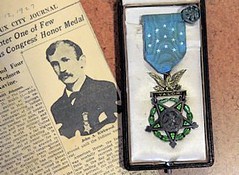 Standing on the hangar deck of the World War II aircraft carrier Yorktown, officials with the Patriots Point Naval and Maritime Museum announced plans Wednesday for a $100 million Medal of Honor Museum honoring the recipients of the nation’s highest award for valor.
Standing on the hangar deck of the World War II aircraft carrier Yorktown, officials with the Patriots Point Naval and Maritime Museum announced plans Wednesday for a $100 million Medal of Honor Museum honoring the recipients of the nation’s highest award for valor.
The museum on high ground on Charleston Harbor would replace a smaller one aboard the carrier and make Patriots Point a national destination, said Ray Chandler, the chairman of the Patriots Point Development Authority.
The authority has signed a letter of understanding with the Congressional Medal of Honor Society to build a museum “honoring the highest heroes of this country,” he said.
Retired Maj. Gen. James Livingston, a South Carolina recipient of the medal, wants to move quickly.
“This is the final opportunity to establish a lasting legacy for the Medal of Honor while we still have recipients alive from World War II, Korea, Vietnam and the War on Terror,” he said.
Livingston, who is on the organizing committee for the foundation, said of the 3,456 recipients of the honor, only 81 are still living. Their average age is 73. He said it is fitting for Charleston to be the location for the new museum. The Medal of Honor was established during the Civil War, which began with the bombardment of Fort Sumter on Charleston Harbor.
A master plan for the museum released Wednesday envisions, among other attractions, a uniform collection, a large format theater with multiple video screens where visitors can learn about sacrifices for freedom, a Great Hall honoring the medal recipients and an interactive media gallery where visitors can hear each recipient’s story.
To read the complete article, see: Charleston plans $100 million Medal of Honor Museum (www.thestate.com/2012/08/02/2379265/charleston-plans-100-million-medal.html#.UB7vIU1lTIg)

A visitor looks at a display at the Medal of Honor Museum
aboard the aircraft carrier USS Yorktown
The project is expected to cost more than $100 million. In addition, the museum will be supported by a multi-million dollar hospitality and consumer component that will feature a world-class destination hotel with amenities, including a conference center.
“We fully expect that this project will serve as a catalyst for additional investments at Patriots Point,” Chandler stated. “This will include both cultural and appropriate commercial and hospitality uses of the highest quality.” It is estimated that by the third year of its operation, the National Medal of Honor Museum will attract more than 200,000 visitors per year.
To read the complete article, see: Patriots Point selected as site of National Medal of Honor Museum (www.artdaily.org/index.asp?int_sec=2&int_new=56939#.UB6gcE1lTIg)
MORE ON SRI LANKAN NUMISMATICS
That note of featured previously in E-sylum in 22 Nov 2009 See www.coinbooks.org/esylum_v12n47a24.html .
There are few nicer numismatic packs sold by the Central Bank of Sri Lanka www.cbsl.gov.lk/htm/english/13_cart/products.asp .
The numismatic collection at the Colombo National Museum and the Central Bank Museum are nice to visit. There are also some nice coins on display at the Dutch Period Museum.in Pettah I don't remember the collection in Kandy.
If any numismatist is visiting Lanka please contact me at Kavanr@gmail.com I will love to meet, and maybe if you are in Colombo on the 3rd Sunday of the month attend a meeting of the Sri Lanka Numismatic Society
See also http://coins.lakdiva.org .
According to
www.sundaytimes.lk/120729/business-times/sri-lanka-has-second
-largest-expat-population-in-the-world-6980.html
.
Sri Lanka’s expatriate population is the second largest in the world in per capita population terms, next only to Lebanon;
To read the earlier E-Sylum article, see: KATIE DE SILVA'S SRI LANKA REPORT (www.coinbooks.org/esylum_v15n32a13.html)
NOTES FROM E-SYLUM READERS: AUGUST 5, 2012
First Coins of the New Year
Ginger Rapsus writes:
For many years, I have noted the day I receive the first coin of the new year, cent or no. Not including the Statehood quarters, the earliest I ever got a new year coin in change was January 15, 1972. It was an Ike dollar.
To read the earlier E-Sylum article, see: CHARMING CUSTOM: FIND FIRST CENT OF THE NEW YEAR (www.coinbooks.org/esylum_v15n32a17.html)
Chopmark Collectors Club Dues
Regarding Howard Daniel's statement that "The Chopmark Collectors Club has no dues in the club but donations are requested for its operation and mailing the newsletter", Joe Boling writes:
When the Chopmark Collectors Club was re-vitalized and the Chopmark News was re-established, the dues were indeed zero, but now if you get a mailed copy of the newsletter, there is a charge. Those who get it via email are assessed no dues. The hard copy costs from $10-$25/year depending in the kind of production you want and the delivery option chosen (air or sea). It comes from Taiwan.
I confirmed this with Chopmark News editor Colin Gullberg who writes:
Yes, the information is correct. Subscriptions cost $10 - 25 depending [on type of subscription], e-editions are currently free. Donations are encouraged.
To read the earlier E-Sylum article, see: THE CHOPMARK COLLECTORS CLUB (www.coinbooks.org/esylum_v15n32a12.html)
Armenia's New Noah's Ark Coin
P.K. Saha forwarded these images of a new 500 Dram coin from Armenia picturing
Noah's Ark. I like it. Does anyone know if the Ark ever been on a coin before?
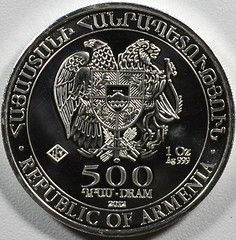
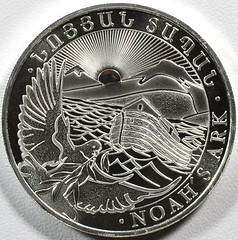
END OF RESEARCH TRAIL FOR LINCOLN MEDALIST BYRON M. PICKETT
This numismatic research adventure started for me as I cataloged the medals for Medallic Art Company in the late 1960s. One of the medals the firm had made was a Lincoln Medal for the Lincoln National Life Insurance Company struck in 1963.
The Insurance company had sponsored a museum of Lincoln items since 1926. One of their acquisitions was a Lincoln Plaque issued in 1908 by a promoter I.G. Muller of a Lincoln bas-relief made in 1873. Muller identified the Lincoln portrait only as "Pickett Head." And that is all the museum knew.
On one of my research trips to the New York Public Library I searched the art division's card catalog (remember card catalogs old-timers?). I found a Pickett with two items in an 1873 auction catalog. It listed the artist's name and a two-word lot description: "Florence--Medallion." Further search located no other Pickett.
I wrote the Lincoln Museum Director, R. Gerald McMurtry. He assured me this was the correct artist. "Perhaps, you have made an important discovery in finding a reference to Byron M. Pickett." he wrote.
Five years later on a family trip west we stopped in Fort Wayne to visit Kenneth Hallenbeck, now past ANA president (and father of present ANA president, Thomas G. Hallenbeck). I reported this in an E-Sylum article (vol 11, no 11, article 12) where I related that my family slept in the Hallenbeck driveway (actually in a motor home). Ken was an employee of the Insurance company and he agreed to introduce me to the museum director the next day.
At the museum I saw a card below the Pickett Head on exhibit and quickly copied down the data. This Pickett Head, the data revealed, was the source of the design for two U.S. Postal Cards issued 1911 to 1917. I researched this further and wrote an article in Linn's Stamp News 24 March 1980. This was rewritten for an article in Postal Stationery (May-June 1980).
Fast forward to 2006. It was one of those articles that attracted the attention of Ron Haney of Rochester New York. Ron is a great grand-nephew of Pickett and was seeking data on his relative when he stumbled on my article. He wrote and we began an active email correspondence. I was as eager to learn about Byron M. Pickett as an artist as Ron was as active learning of a predecessor. I immediately sent Ron the listing I had on Pickett in my American Artists Databank.
I recognized his eager interest and in 2008 sent him a packet of all the material I had in my Pickett file, including photos: of the 1873 Lincoln bas-relief plaque, Muller's plaque, Medallic Art Company medal struck in 1963, a 1966 calendar published by the Insurance Company with the Lincoln Medal illustrated on the cover, even a calendar card for the year 1966.
Plus, of course, photocopies of that 1873 auction catalog, a Lincoln Lore publication on the Picket Head plaque, and a photocopy of a page from a Manhattan New York guidebook illustrating the Samuel F.B. Morse Statue, which was Pickett's most famed work of art.
Ron's research continued. He kept me in the loop, and sent copies of each new Pickett item discovered. It was a delight to open each new email.
This week I received the latest -- the capstone of Pickett research. Ron had learned where Pickett was buried, but had no headstone. He ordered one listing both Bryon and wife Ella, and had it installed in place at the Brookside Cemetery in Tenafly, New Jersey.
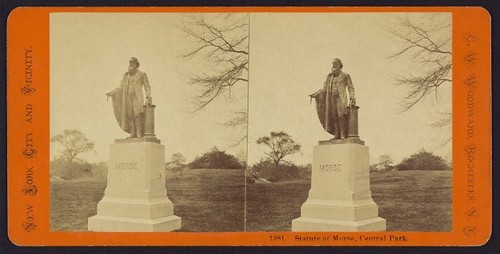
Byron Pickett's Samuel F.B. Morse statue
A local newspaper ran this article August 5:
American sculptor Byron M. Pickett is memorialized
(auburnpub.com/columnists/dawn_roe/american-sculptor-byron
-m-pickett-is-memorialized/article_b4f71320-bcab-5c48-b2da-9b790ba7eea7.html)
To read the earlier E-Sylum article, see: LARGEST LINCOLN NUMISMATIC COLLECTION IN LIMB (www.coinbooks.org/esylum_v11n11a12.html)
CARSON CITY COIN COLLECTION ARTICLES
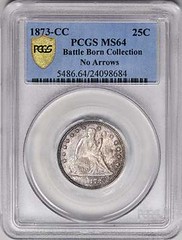 Add up their face value, and the 111 rare coins in the "Battle Born Collection" amount to under $600.
Add up their face value, and the 111 rare coins in the "Battle Born Collection" amount to under $600.
But throw in their lure to coin enthusiasts - each struck in the Carson City Mint between 1870 and 1893 with the most prized coin the only known 1873 "No Arrows" Seated Liberty dime to exist - and the price tag soars.
Their owner, an anonymous Nevadan, could earn $11 million-$15 million at auction next week in Philadelphia, and a Reno coin dealer assisting him in the process says it will be a once-in-a-lifetime event.
"This is my Olympic moment," Rusty Goe, owner of Southgate Coins, said Tuesday of the upcoming sale, part of the Rarities Night Auction at the American Numismatic Association's World's Fair of Money Convention. "This is the biggest event that's ever happened to me in my 30-year career as a coin collector."
Goe serves as a paid consultant to the collection's owner, whom Goe refers to only as "Mr. Battle Born" after Nevada's state motto.
Until the coins are sold individually at auction, they remain the only complete collection of coins made in the Carson City Mint, Goe said. They represent each of the 111 different date-and-denomination combinations issued from the Mint before it closed in 1893 in what is now the home of the Nevada State Museum.
The auction's success could be affected by potential buyers' confidence at the moment with market conditions, Goe said, adding, "We just won't know for sure until then. We'll see how close we come to our pre-sale estimates."
Either way, Goe hopes to use the event as a showcase for Nevada and the Carson City Mint's opening at the height of the Comstock Lode era.
He's already convinced Stack's Bowers Galleries of Irvine, Calif., which will put on the auction, to print a separate catalog on the Battle Born Collection in addition to the main publication for participants.
He also said a bit of historic irony has not been lost: The Philadelphia Mint, the nation's first opened in 1792, opposed creating a Carson City branch when the issue was debated in Congress in the 1860s.
"They said, why do we want to put a mint in that heathen territory, a Wild West area like that? So for this one night, Carson City will steal the show from the Philadelphia Mint," he said.
To read the complete article, see: Rare Carson City coins going to auction (www.usatoday.com/news/nation/story/2012-08-01/rare-carson-city-coins/56647974/1)
To read the complete article, see:
'Battle Born:' Rare Carson Mint coins going to auction on Philadelphia stage
(www.rgj.com/article/20120801/BIZ/308010046/-
Battle-Born-Rare-Carson-Mint-coins-going-auction-Philadelphia-stage)
QUERY: AN ENGRAVED 1840-O HALF DOLLAR
Club member Brian Greer sent in an interesting 1840-O half dollar (imaged below). It is a WB- 13, a rare variety. On first appearance, it is a very nice original XF coin but close observation shows hand engraving on the reverse. The engraving says “13.244 grams” which appears to be contemporary. Assuming it to be the weight of the coin, I weighed the half dollar with my modern digital scale and came up with 13.24 grams! Indeed, it is the weight of the coin.
Now for the hard part, other than to prove the weight of the coin for some reason, why would you want to weigh and annotate this commonly (then!) circulating half dollar. Think about it and send your comments to the E-Gobrecht editor.
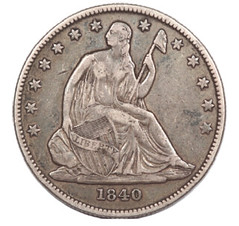

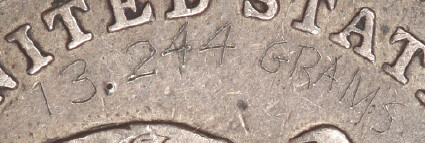
ANNA HYATT HUNTINGTON'S 1943 AFRICAN ANIMALS MEDAL
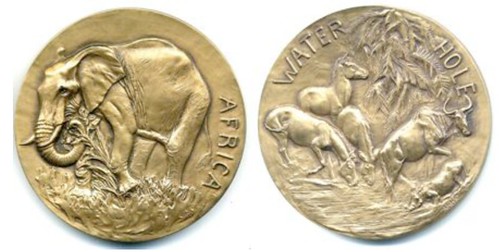
AFRICAN ANIMALS, 1943. A: SOM-27. Golden Bronze. Edge B. 73mm. Bronze. Anna Hyatt
Huntington, Sc. (MACO). Uncirculated. With scattered dark spots on both sides. The obverse bears an imposing view of an African elephant plodding through the jungle grass, while the reverse depicts a variety of African wildlife at a water hole.
This was the 27h issue of the Society of Medalists. It is one of the few medals in the series to which there is not “story” attached. Mrs. Huntington states, “African animals and their great variety of form and color are an unending source of delight to the animalier and personally, I am always happy when I can get the excuse to work on them, so this composition was done from a selfish point of view to amuse myself.”
Apparently, collectors have also be “amused” by this delightful medal as it is one of the most popular in the series. Original box and descriptive pamphlet. $210.00
THE BOOK BAZARRE
ROBERT W. JULIAN NAMED ANA'S 2012 NUMISMATIST OF THE YEAR
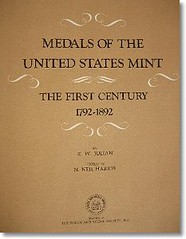 Robert W. Julian has been named the American Numismatic Association’s 2012 Numismatist of the Year. Julian will receive his award on Aug. 10 during the Awards Banquet at the ANA World’s Fair of Money in Philadelphia.
Robert W. Julian has been named the American Numismatic Association’s 2012 Numismatist of the Year. Julian will receive his award on Aug. 10 during the Awards Banquet at the ANA World’s Fair of Money in Philadelphia.
A researcher and prolific, award-winning author, Julian is perhaps best known for his quintessential work Medals of the United States Mint: The First Century, 1792-1892, published in 1977. Other books include From Rus to Revolution: Russian Coins through a Thousand Years (1988); Medals of the United States Assay Commission, 1869-1977 (1989); and Russian Silver Coinage, 1796-1917 (1993).
To Julian, coins speak volumes—about history, economics and American culture. “I gain satisfaction from finding new and interesting information about coins and medals that has remained unpublished or little known,” he said. “As I study documents in the National Archives, I have the sense of being at the writers’ sides as they pen U.S. Mint history into the dusty ledgers.”
“(Julian’s) first publication was an article on the coinage of Czar Alexander II that appeared in Numismatic Scrapbook in 1960. Since then, he has published more than 1,300 articles in all the significant commercial and organizational numismatic publications in the United States and some overseas,” said Joseph E. Boling, who nominated Julian for the award. “He has spent hundreds of hours at the National Archives, extracting information that he then passes to the collecting community. His carefully researched treatises, most based on primary sources, have changed our common knowledge.”
He’s one of those semi-familiar names who has accomplished as much or more in his field than others with greater notoriety. That’s what happens when a person quietly and diligently goes about his business for more than half a century.
Author and researcher R.W. “Bob” Julian will be honored as the American Numismatic Association‘s Numismatist of the Year during the upcoming ANA summer convention in Philadelphia. Julian’s byline has been a regular sight in coin publications since the early 1960s, and he can do more than write magazine-length articles.
Medals of the United States Mint – The First Century is still regarded as a “must read” book 35 years after its 1977 publication by the Token and Medal Society. It was the product of thorough research and an unwavering commitment to accuracy. In other words, a typical Julian effort.
“I spent 12 or 13 weeks at the National Archives in 1975 and 1976 doing research for the book,” Julian said. “My first visit to the National Archives was in 1963. You soon learn that your hand wears out taking notes, so I started using a reel to reel tape recorder.”
Like many who grew up in the 1950s, Julian’s interest in coins was sparked by checking dates on Lincoln cents. The Logansport, Ind. native quickly moved on to a much different area of numismatics.
“There was a local coin dealer, and I would go to his shop,” Julian recalls. “He had trouble identifying his foreign coins, so I did it. There was no pay involved, but I would receive five or 10 coins out of every lot for my work. The czarist Russian coins looked neat, so I started collecting them.”
The interest in Russian coinage has never waned. Julian’s term paper on Russian monetary reform in the 1800s caught the attention of a professor at Purdue University.
“The professor liked it so much that he recommended I try and get the paper published,” Julian said. That led to a number of articles on Russian coins for the Numismatic Scrapbook and The Numismatist.
His hunger for knowledge and verifiable information was evident even at a young age. Julian corresponded with the Hermitage in Leningrad (now St. Petersburg) in an effort to learn more about Russian coinage. That was an unusual move during the height of the Cold War era.
The Hermitage’s staff numismatist offered to microfilm Russian-language numismatic books. The cost was $100, a significant sum at a time when a new car could be purchased for $2000. Julian came up with the cash.
“I can read Russian slowly and catch snippets of conversation,” he said. “It’s all self taught.” Speaking of teaching, Julian made his living as a math teacher in Logansport for 30 years and spent much of his free time in numismatic research and writing.
“Nobody gets rich writing articles, but I just enjoy finding new material and publishing it,” he said. A good chunk of Julian’s earnings as a coin writer were used to feed his quest for knowledge, and that led to a problem which required a creative solution.
“There’s a little home I bought and fixed up to keep my library of 5000 to 7000 books,” Julian said. The converted home also serves as his office. Although he doesn’t keep track of the hours spent on writing and research, it’s much more than a casual pastime for the retired teacher.
To read the complete article, see: MEET THE 2012 NUMISMATIST OF THE YEAR (www.coinweek.com/people-in-the-news/meet-the-2012-numismatist-of-the-year/)
DAVID E. SCHENKMAN TO RECEIVE LIFETIME ACHIEVEMENT AWARD
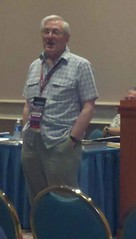 Author and Summer Seminar instructor David E. Schenkman will receive the American Numismatic Association’s Lifetime Achievement Award on Aug. 10 during the World’s Fair of Money in Philadelphia.
Author and Summer Seminar instructor David E. Schenkman will receive the American Numismatic Association’s Lifetime Achievement Award on Aug. 10 during the World’s Fair of Money in Philadelphia.
Schenkman has shared his knowledge of tokens with collectors since his first article was published in 1964. Every one of his eight books is considered a standard reference. He has been a columnist and contributing editor for The Numismatist for many years and won an ANA Heath Literary Award in 1994.
He edited the Token and Medal Society publications for 27 years, the Civil War Token Society journal for five years, and he served as president of both clubs. Schenkman also is a member of the American Vecturist Association, National Scrip Collectors Association and Numismatic Literary Guild.
In addition to teaching ANA Summer Seminar students about U.S. tokens and Civil War-era numismatics for 17 years, Schenkman has presented many talks at the Association’s conventions. He has prepared competitive exhibits at state, regional and national shows, taking home a number of awards. He received the ANA Glenn Smedley Memorial Award in 2003 and Medal of Merit in 2007.
JOHN NEBEL AWARDED ANA'S MEDAL OF MERIT
ANA life member John Nebel is a computer consultant who has volunteered his time and expertise to meet the Association’s technology needs. A Colorado resident, Nebel has taught numismatic photography at the ANA Summer Seminar, where he supports scholarship programs by donating high-value ancient coins to the Young Numismatist Benefit Auction. His numismatic photographs grace the ANA’s Colorado Springs headquarters as well as the pages of The Numismatist, and he freely shares images of ancient Greek and Roman coinage on his website, www.ancientmoney.org .
Nebel’s firm, Computer Systems Design Company, hosts the websites of more than 50 ANA-member clubs at no charge. Thanks to CSDC, the ANA’s Bebee Collection of U.S. Paper Money also has been digitized and made accessible online for all. Nebel has been recognized with a Presidential Award (2009) and the Glenn Smedley Memorial Award (2010).
AN INTERVIEW WITH ROBERT HOGE
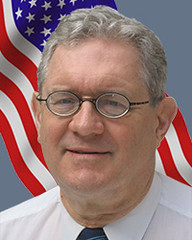 Robert Hoge was sworn into the Citizens Coinage Advisory Committee (CCAC) on April 26th, 2012. He was appointed as the member specially qualified to serve by virtue of his education, training or experience in numismatic curation. Mr. Hoge is curator of North American Coins and Currency for the American Numismatic Society (ANS), and an award-winning columnist of ANS Magazine. In addition, he is president of the New York Numismatic Club. From 1981 to 2001, he served as curator for the ANA's Money Museum in Colorado Springs and manager of its Authentication Bureau. Mr. Hoge holds a Bachelor of Arts degree in anthropology and history from the University of Colorado at Boulder, and a teaching certification in social sciences.
Robert Hoge was sworn into the Citizens Coinage Advisory Committee (CCAC) on April 26th, 2012. He was appointed as the member specially qualified to serve by virtue of his education, training or experience in numismatic curation. Mr. Hoge is curator of North American Coins and Currency for the American Numismatic Society (ANS), and an award-winning columnist of ANS Magazine. In addition, he is president of the New York Numismatic Club. From 1981 to 2001, he served as curator for the ANA's Money Museum in Colorado Springs and manager of its Authentication Bureau. Mr. Hoge holds a Bachelor of Arts degree in anthropology and history from the University of Colorado at Boulder, and a teaching certification in social sciences.
Mr. Hoge agreed to answer some questions regarding his entry into numismatics, and his thoughts on the U.S. Mint and the CCAC.
What is your earliest coin collecting memory?
At ten years old, I found a coin (it actually turned out to be a token) in the dirt floor of a garage/shed at my family home. This piqued my imagination, and I wanted to identify and learn something about it. The thing appeared to be a $20 gold piece, but was clearly made of brass. It was very badly worn and pitted, but eventually I was able to figure out that it was a circa 1850s spielmark. My parents started supporting my new interest by encouraging me and giving me actual old coins.
How did you start collecting coins?
With some coins initially given to me by family members and friends, I began reading about coin collecting and studying the relationships of numismatics to history and archaeology. I saved all the older or more unusual ones I could find, and was thrilled when other school children showed me different coins that they had found or gotten from their parents. Scouting introduced me to the idea of collecting coins by series. My father had collected U.S. coins years earlier, and started giving me his partially-filled little blue Whitman albums. My mother made note of interesting coins that I happened to have mentioned, and began to hunt for dealers from whom she could get some for me as little gifts. I started seeking magazine advertisements listing coins for sale and upcoming coin shows, started acquiring a few inexpensive coins from dealers, and bothered my parents to help with this. I had a broad interest in the past, and a good memory; consequently, my numismatic proclivity burgeoned.
What coins do you collect?
I do not actively collect anything today, although in the past my numismatic interests have varied fairly widely, to the extent I could afford to make occasional purchases. From my initial fondness for Early American coins, I moved toward ancient and oriental issues as I studied languages and cultures, and I have collected many series -- as long as they contained diverting items that were relatively inexpensive. I never managed to complete any sets of United States coins of any kind, unfortunately, but I suppose I should confess that I do possess examples of coinage of most of the Roman emperors and British monarchs, for example – areas in which I have devoted more focused study.
To read the complete article, see: Interview with Robert Hoge, CCAC Member (news.coinupdate.com/interview-with-robert-hoge-ccac-member-1511/)
ANS RAYMOND H. WILLIAMSON CORRESPONDENCE ARCHIVE
Raymond H. Williamson correspondence, 1949-1996 0.5 cubic feet (1 box)
Biographical note
Raymond H. Williamson (1907-1997) was a collector primarily of U.S. large cents. He was born in Eagle Grove, Iowa, and earned degrees in electrical engineering from Iowa State (B.S., 1928) and Union College, Schenectady, New York (M.S., 1935). He worked for General Electric for 43 years before his retirement in 1972. He and his wife Hazel settled in Lynchburg, Virginia, in 1958, which is where he died.
Williamson had an early interest in radio, operating an amateur station from 1921 to 1926. He managed a naval radio telegraph transmitter in the Panama Canal Zone in 1936 and 1939 and was chairman of the FM Broadcast Engineering Committee that set industry standards from 1942 to 1953. He began collecting coins in 1917 and published articles in The Numismatist, The Colonial Newsletter, Penny-Wise, The Virginia Numismatist, and other publications. Williamson became an associate member of the American Numismatic Society in 1949, a fellow in 1957, and chaired the Society’s U.S. coins committee in the 1950s. He was a member of the American Numismatic Association, Virginia Numismatic Association, and was charter member number 54 of the Early American Copper Society. He served on the U.S. Assay Commission in 1968.
Collection
Contains original and photocopied correspondence with Walter H. Breen, author of numerous numismatic works, including Proof Coins Struck by the United States Mint, 1817-1921 (1953), Walter Breen’s Encyclopedia of United States Half Cents (1984), and Walter Breen’s Complete Encyclopedia of U.S. and Colonial Coins (1988).
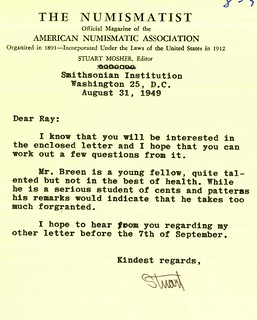 Williamson’s early correspondence (1949-1953) with the young Breen document a time when Breen was conducting research for coin dealer Wayte Raymond at the National Archives and the U.S. Mint and working at the Smithsonian Institution with Stuart Mosher, editor of The Numismatist. Also during that period, Breen worked briefly at the coin auction firm Stack’s, was a student at Johns Hopkins University, and began publishing on early American coinage. The letters reveal a friendship built around shared numismatic research interests.
Williamson’s early correspondence (1949-1953) with the young Breen document a time when Breen was conducting research for coin dealer Wayte Raymond at the National Archives and the U.S. Mint and working at the Smithsonian Institution with Stuart Mosher, editor of The Numismatist. Also during that period, Breen worked briefly at the coin auction firm Stack’s, was a student at Johns Hopkins University, and began publishing on early American coinage. The letters reveal a friendship built around shared numismatic research interests.
To read the complete archive entry, see: Raymond H. Williamson correspondence, 1949-1996 0.5 cubic feet (1 box) (numismatics.org/Archives/Bio-williamson)
TIME CAPSULE: A 1994 USENET POST ON THE 1783 NOVA CONSTELLATIO PATTERNS
This week's Numismatic News announced that John Ford's
unique 1783 Nova Constellatio pattern set will be on
display at Stack's table at the ANA Convention next week.
Wow! To me, this set is the ultimate U.S. numismatic treasure,
far more important historically than the King of Siam set
(of 1804 Dollar fame).
The coins were struck in April 1783 for Robert Morris,
and were the first attempt to create a national coinage for
the new government. The denominations were based on a unit
equal to 1/440th of a Spanish Milled Dollar. The silver "mark"
was 100 units, the "quint" 500, the "bit" 100. The smallest
was a copper "5".
The following is the story of Ford's acquisition of the set,
as near as I can remember it. I have a tape recording of a talk
he gave one time, and spoke to him in person about it once. He
had a lot of explaining to do to his wife when he needed to liquidate
other assets to come up with some cash after the Garrett sale.
Ford bought the copper "five" in 1977. It was found in a Paris collection
and was sold to a U.S coin dealer who thought it was a pattern for
the later Nova Constellatio copper coinage - he didn't realize it was the
missing link in the Morris set (the other three silver pieces resided
in the Garrett collection at Johns Hopkins University). The dealer
offered it to a wealthy collector who in turn asked John Ford for his
advice. The collector met Ford in midtown Manhattan while on the way
to a fishing trip. As the two shared a cab, the collector pulled the
piece from his shirt pocket and showed it to Ford.
"How much should I pay for it" he asked. "Just buy it," Ford said,
recognizing the significance of the piece. "But how much is it worth?"
"Just BUY it - whatever it takes - BUY it!" The collector put the piece back
in the pocket of his fishing shirt, and left for the woods. When he later
contacted the dealer, the asking price was $20,000, and the collector balked.
He sent the coin back to the dealer.
Before long John Ford got a call himself from the dealer, and later bought the
piece for his own collection. Two years later, Ford bought the remaining
three pieces at the Garrett sale for $425,000. The set of four coins
that passed through the hands of Morris and Thomas Jefferson was united again
after nearly 200 years.
After holding the set for 15 years, Ford is apparently putting it up
for sale. "The price is available on request." Those of us who'd have to
ask, can't afford it. But this collector will make sure he takes the
opportunity to see the coins before they disappear for another 15 years or
more.
Wayne Homren
Pittsburgh, PA
homren@cgi.com
To read the complete article, see: CLM: 1783 Nova Constellatio set for sale (/groups.google.com/forum/?fromgroups#!topic/rec.collecting/TkJyjIKj124)
HUGH SCONYERS AND THE 1982 RARE COIN MARKET
What a lot of people forget about the coin market in 1982 is that it was dismal. After the amazing precious metals price run-ups in 1979 and 1980, the market crashed in 1981 and by 1982, you literally couldn’t give coins away. More on that in a second…
Steve Ivy Rare Coins (which was to soon merge with Jim Halperin to form Heritage Rare Coins) was a great example of just how badly the coin market had been devastated. In 1979-1980, I believe that there were close to 200 people working at the firm. After the market tanked in 1981, most of the staff was let go. When I was hired, I think there were something like a dozen people on the staff. Amazing as it seems today, this small group of employees was tasked with the responsibility of putting together an ANA sale, selling the coins and collecting the money; not to mention the normal buying and selling associated with the show.
As I mentioned above, the coin market in 1982 was appallingly bad. There were tons and tons of great coins around and, compared to the heady days of 1979 and 1980, prices were cheap; sometimes as low as thirty or forty cents on the dollar. The problem was that no one had any money or any confidence in the market.
But, there was, it turned out, one person who was buying coins. His name was Hugh Sconyers.
Hugh wasn’t a real numismatist; he was involved in the investment world and he was known as being one of the smartest people to ever walk a bourse floor. He represented a group of investors who thought coins, in 1982, were cheap and he set out to buy millions of dollars of choice and rare United States pieces. His buying would peak at the Eliasberg sale in October 1982 where he spent millions of dollars on amazing coins.
I never really knew Hugh that well; just mostly by sight and by reputation. I was told his checks were good (no simple feat in 1982…), he was at the show solely to buy coins and this made him The Most Wanted Man at Boston ANA. There was a bit of a problem though. Hugh was a “personality buyer.” What I mean by this is that Hugh bought coins mostly from people he knew and trusted. This meant that a number of dealers who would have given their first born child to have an hour with Hugh at the table buying their coins would never have the opportunity.
As soon as Steve Ivy found out about Hurricane Hugh, he called me over and gave me a new job at the show. The conversation, which lasted about thirty seconds, went like this:
Steve: I want you to stop whatever you are doing and follow Hugh Sconyers around the show and take notes about what he’s buying. I want to know who he buys from, what he’s buying, and how much he’s paying. What are you waiting for? Go!
Me: Uh, OK.
So my first day at my first ANA show as a professional coin dealer went like this: I had a note pad and a pen and I followed Hugh from a distance. Let’s say he stopped at Joe Flynn’s table. I figured my job was to get just close enough that I could spy on Hugh and give a detailed report to Steve. So as Hugh was flipping through Flynn’s double row boxes, I was at the next table pretending to look at coins out in the nearby case(s). Or something like that…
To read the complete article, see: ANA (Mis) Adventures: 1982 (www.raregoldcoins.com/market-blog/ana-mis-adventures-1982)
THE BOOK BAZARRE
THE LONDON 2012 OLYMPIC MEDALS
David Klinger writes:
Here is some information about the current Olympic medals which I found interesting.

- The London 2012 Olympic medals weigh 375-400g, are 85mm in diameter and 7mm thick.
- The gold medal is made up of 92.5% silver and 1.34% gold, with the remainder copper (a minimum of 6g of gold).
- The silver medal is made up of 92.5% silver, with the remainder copper.
- The bronze medal is made up of 97.0% copper, 2.5% zinc and 0.5% tin.
The precious ore for the medals has been supplied by London 2012 sponsor Rio Tinto and was mined at Kennecott Utah Copper Mine near Salt Lake City in America, as well as from the Oyu Tolgoi project in Mongolia. For the small amount of non-precious elements that make up the bronze medals, the zinc was sourced from a mine in Australia as well as from recycled stock, while the tin originates from a mine in Cornwall.
Designed especially for each Games, the medals are what every athlete strives to win.
The medals at the London 2012 Olympic Games will be awarded during a total of 302 Victory Ceremonies, taking places at venues across the UK.
The medals have been designed by David Watkins, an established artist in the field of decorative art, and are in production at the Royal Mint headquarters in Llantrisant, South Wales.
The story behind the medal
The Olympic medals’ circular form is a metaphor for the world. The front of the medal always depicts the same imagery at the Summer Games – the Greek Goddess of Victory, Nike, stepping out of the depiction of the Parthenon to arrive in the Host City.
The design for the reverse features five symbolic elements:
- The curved background implies a bowl similar to the design of an amphitheater.
- The core emblem is an architectural expression, a metaphor for the modern city, and is deliberately jewel-like.
- The grid suggests both a pulling together and a sense of outreach – an image of radiating energy that represents the athletes’ efforts.
- The River Thames in the background is a symbol for London and also suggests a fluttering baroque ribbon, adding a sense of celebration.
- The square is the final balancing motif of the design, opposing the overall circularity of the design, emphasising its focus on the centre and reinforcing the sense of ‘place’ as in a map inset.
How the designs were chosen
When creating the brief, the London 2012 Organising Committee (LOCOG) Victory Ceremonies team worked closely with the British Museum’s Keeper of Coins and Medals, Philip Attwood, to look at the symbolic history of medals in Europe in the last century.
An independent panel of Sir John Sorrel (chair), Sir Mark Jones, Catherine Johnson, Ade Adepitan (deputy chair), Iwona Blazwick OBE, Niccy Hallifax and Martin Green was set up to look at the designs submitted by over 100 artists. The LOCOG Athletes’ Committee, chaired by Jonathan Edwards, and the British Olympic Association (BOA) were also involved throughout the process.
The medals can be seen at the British Museum throughout the Games.
To read the complete article, see: www.london2012.com/medals/about/
BELGIUM'S BELGA CURRENCY
 About a decade ago I spotted a Belgian share of the Walburg textile company from the city of St-Niklaas.
About a decade ago I spotted a Belgian share of the Walburg textile company from the city of St-Niklaas.
At first sight it looked like a rather plain certificate. But I was puzzled because it was not mentioning the familiar Belgian Franc as its currency denomination but Belgas. Thundering typhoons, what were Belgas?
A strong Belgian Franc for King Leopold II
In 1865 king Leopold II was made king of Belgium. In these days most national currencies were made out of gold and silver. In the very same year Belgium, France, Greece, Italy and Switzerland established the Latin Monetary Union (LMU). The LMU countries agreed to change their national currencies to a standard of 4.5 grams of silver or 0.290322 gram of gold (a ratio of 15.5 to 1) and make them freely interchangeable. In this period, which lasted until World War I, the Belgian franc was considered a stable and strong currency, a situation which resembled the international ambitions of the king of making Belgium a more powerful nation amongst other great nations.
Reichsmarks induce Belgium inflation
During World War I the Reichsmark became the only official currency in Belgium. At the end of the war, the Belgian economy was immersed in Reichsmarks and for their exchange against Belgian francs, the government preserved the overvalued currency rate of the occupier. As a result, the war inflation was transferred onto the peace economy, causing prices to increase and the value of the Belgian Franc to decrease.
The following years saw a continuous fall of the value of the Franc in comparison to the Pound Sterling and the US Dollar, causing further flight of Belgian capital. Eventually, the government Poullet-Vandervelde was forced to resign. Strong measures were needed to stabilize the Belgian currency and to put the evolution of the Belgian national debt back on the right track.
Belgium leaves the Latin Monetary Union and introduces the Belga
At the end of 1925, Belgium, wanting to regain full monetary autonomy, decided to withdraw itself from the Latin Monetary Union by 1927. It would mean the end of the LMU. The Belgian decision meant a clear disruption of its monetary alignment with the French Franc. In 1926, the new government Jaspar works out a stabilizing program for the Belgian Franc. The introduction of the Belga currency was one of several components of the plan. One Belga was equal to 5 Belgian francs. In order to clearly distinguish this new Belgian valuta against the other currencies, especially the French Franc, all exchange operations had to be realised in Belga.
Belga coexists with Belgian Franc
However, the Belgian Franc did not disappear, because the newly issued coins and notes always mentioned their value in both the Belga as the Belgian Franc currency.
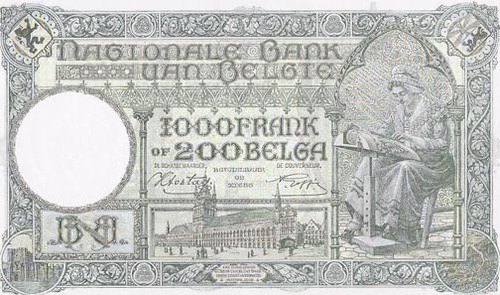
1927 saw appearing the first notes mentioning both currencies and 3 year laters ‘Belga-Franc’ coins appeared on the market. Nevertheless, the plan was a success and did stabilize the Belgian currency.
The Belga was not popular when it was used and it was soon forgotten after it disappeared from the market. In the past decades the Belga was seldom mentioned in history lessons at schools, so nowadays few people know about its past existence. And that explains the mystery of the Belga, people simply forgot about the Belga except for collectors of coins and notes.
To read the complete article, see: Twenty years of Belgas (www.coinsweekly.com/en/Twenty-years-of-Belgas/8?&id=210&type=a)
FEATURED WEB PAGE: UNITED STATES MINT POSTCARDS
This week's Featured Web Page, suggested by David Lange, has images of Stereoviews, Post Cards etc. illustrating scenes of and at the various United States Mint buildings."Write Karl Moulton and get him to publish his collection of these cards" Alan Meghrig
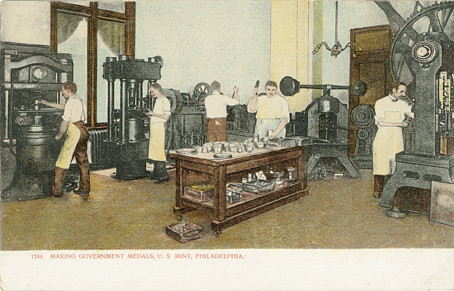
www.coincats.com/PostCards.html
